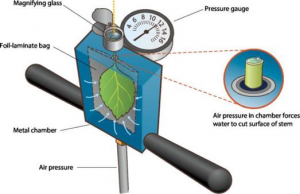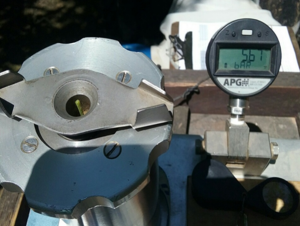Allan Fulton, Irrigation and Water Resources Advisor, Tehama, Shasta, Glenn & Colusa Counties; Luke Milliron, Orchards Advisor, Butte, Tehama & Glenn Counties, and Richard Buchner, Emeritus Orchards Advisor, Tehama County.
Stem Water Potential (SWP) Concept
A pressure chamber measures plant water tension by applying pressure to a severed leaf and stem enclosed in an airtight chamber (Fig. 1). The sample leaf is covered with a foil-laminate bag for at least ten minutes before being excised from the tree, and remains in the bag while the measurement is taken. The pressure required to force water out of the stem of a severed leaf equals the water potential and is measured by a pressure gauge. As soil moisture is depleted, more tension develops in the plant, requiring more pressure to force water out of the cut surface of the leaf stem.

Figure 1. Schematic showing how water potential is measured in a severed leaf and stem (petiole) using a hand-held pump-up pressure chamber. Source: Adapted from Plant Moisture Stress (PMS) Instrument Company. Click photo to enlarge.
Stem water potential (SWP) is a direct measure of water tension (negative pressure) within the plant and is given in metric units of pressure, such as bars (1 bar is about 1 atmosphere of pressure, or 14.5 psi). Technically, SWP should always be shown as a negative value (e.g., –10 bars), but in conversation and because the gauge does not indicate negative values, we often omit mentioning “negative” before the value. A larger number on the gauge indicates more tree water stress.
Actual Field Measurement
An actual measurement is shown in the photo below (Fig. 2). On the left, a walnut stem protrudes out of the top of a pressure chamber. In this example, the length of stem protruding out of the chamber is about a 1/2 inch to help show the end point in this picture. Some suggest the stem protrusion should not exceed 1/8 to 1/4 inch but there is no evidence that it affects the measurement from a practical perspective. It is also easier to view the end point with a longer stem. The end point of the measurement is defined as the point when water exudes out of the stem and begins to completely cover the cut surface. A pressure gauge is shown at the right of the photo. In this case, a digital gauge is used and measures to the second decimal. Most pressure chambers come with dial gauges to reduce cost. Measurements to the first decimal is more than sufficient.

Figure 2. Photo of actual SWP measurement in walnut using a pressure chamber with digital gauge. Plant water status of this walnut tree was -5.67 bars tension (rounded to nearest tenth,-5.7 bars). Photo: C. Haynes. Click photo to enlarge.
Note: This is the second article in a series on stem water potential. Read the first article here. This series is an an abbreviated discussion based upon peer-reviewed UC ANR Publication 8503, Using the Pressure Chamber for Irrigation Management in Walnut, Almond, and Prune (2014).


Leave a Reply